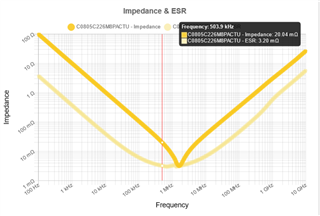Hello! I am trying to use the equations in section 9.2.2 in the LMR51420 datasheet to solve for inductor and capacitor selections. However, using the example design targets in table 9-3 does not give me the same values given throughout section 9.2.2. I've triple checked the equations I wrote in excel and they appear to match the datasheet. Maybe I'm understanding them wrong? See attached excel document.LMR51420_ComponentSelection.xlsx
Inputs & Outputs
Cells A3 - J3 contain inputs that match table 9-3 in the datasheet.
Row 6 and 7 contain inputs that can be copy/pasted into cells A3 - J3. Row 7 matches the datasheet. Row 6 contains the target numbers for my application.
Cells A12 - G12 contain constants that are either fixed in the datasheet (like switching frequency) or intermediate constants like those described at the end of section 9.2.2.5.
Cells A17 - E17 are the primary outputs we care about: R_FBB, minimum inductance, maximum ESR, minimum C_out.
Equations that work
Equation 9: R_FBT and R_FBB are solved in cell H3 and A16 and matches the values shown in 9.2.2.2.
Equation 14: C_OUT-minimum is solved for in cell E17 and matches the 32μF value in datasheet section 9.2.2.5.
Equations that I'm uncertain are working
Equation 10: Δi_L is solved in B12 but there is no reference value in the datasheet to know if this is correct. Is this supposed to be the RMS current referenced in 9.2.2.4? If so then it should be 3 A but I am getting 0.6 A.
Equations that aren't working
Equation 11: Minimum inductance is solved for in cell B17. It does not match the datasheet value of 9.7μH, it shows 14μH. I'm off by 44%.
Equation 12: Maximum ESR is solved for in cell C17. 9.2.2.5 says this should compute to 75mΩ but I am getting 41 mΩ. I'm off by 54%.
Equation 13: C_OUT-minimum is solved in D17. 9.2.2.5 says this should compute to 12μF but I am getting 6 μF. I'm off by 50%.
Questions
Ultimately I'm just wondering "What am I doing wrong?". My guess is I am not understanding some of the units correctly in the constants listed in cells A12 - G12. WEBENCH has this part number listed and solves for C_OUT and L values close to the datasheet but are still a little off compared to the datasheet example.
Any help would be appreciated, thanks!



